April 12, 2019
We left the ship in Shanghai yesterday morning at 4:30 AM and the port agent was there to escort us off the ship and to the waiting taxi. The ship was leaving at 6 AM. Our flight was at 8:15 and we were a little delayed but not long. I was hoping that I might buy from the Pandora shop but they didn’t open until 8 and we were on the plane by then. We had a change of planes in Kumming, which is in the center of China and had to go through immigration then before boarding the flight to Kathmandu. Both of the flights were fine, interesting Asian meals on both. I saw this little sweetie at the airport and the flowers were beautiful.
As I mentioned, China is all on one time zone so there was no change in time there, but Nepal is 2 hours and 15 minutes behind China time.
The travel agency sent a representative, Ashish, and a driver to pick us up. Ashish said that we were very quick to leave the airport, sometimes it takes people 3 hours! I guess that is because we applied for our Nepal visa online instead of waiting till we got there, which is apparently the choice most people make. There were long lines for that while it took only about 10 minutes for us to get the visa in our passports and for me to get local currency. Ashish greeted us with these scarves which is a typical welcome here.
Then we were on our way to the Hyatt Regency and a nice dinner and rest. The hotel is huge and beautiful. We were greeted with beverages and there was traditional music being played in the lobby. Here are some evening pictures and some from this morning when we had a walk all around the property.
There is even a casino in one part of the hotel!
Ashish and our guide, Sagar (Sagar is on the right) greeted us for the 9 AM start to our tour. The weather is beautiful and we were ready to go.
First of all, the traffic is CRAZY here. The roads are in terrible shape since the earthquake in 2015. In some areas they are putting in water pipes and are going to also bury the electric wires. I don’t know how they can figure out what they are all for! They drive on the opposite side and people cross just everywhere, there are motorbikes weaving in and out and goats along the side of the roads. I really admire our driver.
Sagar is a great guide. We will have him for all of the days we are in Nepal and he is a wealth of information. He talked about the earthquake in 2015 that destroyed many temples and homes. 9000 people died and 22,000 were injured.
Nepal is a Federal Democratic Republic and has a population of 28 million – 4.8 million live in the Kathmandu valley. There are 101 different ethnic groups and 92 languages spoken in this country! The official language is Nepali and everyone learns English. Most speak it incredibly well.
There are three cities inside the Kathmandu Valley – Kathmandu (Kantipur – the city of Glory), Patan (Lalitpur – the city of Art) and Bhadgau (Bhaktapur – The city of Devotees)
The currency is the rupee and right now the exchange rate is 111 rupees to $1 US.
This is the flag of Nepal. It is unusual in that most flags are rectangular.
Sagar took us to “Freak Street” which was a drug and hippie haven in the 70’s. It is just near Durbar Square. There were many people selling their merchandise near this street and Sagar told us to just say no thank you and not to say, “later” because they will wait and hold you to it! The knife is a Gorkha knife – used by the Gorkha soldiers. They are called to serve in many capacities around the world, and provided the security for the Trump – Kim summit in Singapore.
The house with the orange areas is where Jimi Hendrix stayed!
Next we went to Kathmandu Durbar Square. It is famous for its exquisite architecture and artistic embellishment. The complex of palaces, courtyards and temples that were built in 1200 to 1768 AD used to be the seat of the ancient kings of Kathmandu. There are 2300 temples in the Kathmandu valley.
Here are some pictures of this amazing site.
The old and the more modern are right next to each other. The white neoclassical building is the eastern side of the palace. It is an imported European style building built as part of the palace in 1908.
You can see that the temple in the middle picture was totally destroyed and is being rebuilt. Many are in that state of rebuilding and they are often funded by other countries – China, Japan and the US are three of the countries that are helping.
Here are some pictures of the work.
We went into the Kumari-ghar courtyard and waited for about 40 minutes hoping to get a glimpse of the Kumari, or living goddess who is considered to be an incarnation of the goddess Taleju. She appears from time to time in the middle window in the company of her guardian priestess to see and be seen by her admirers. You are definitely not allowed to take any photos of her and we were reminded many times. Sagar says she doesn’t always appear. She is selected for her physical attributes at age 5! And she is sequestered in this building, only allowed out 13 times in a year. Once she begins to menstruate, a new living goddess is selected and the former one can go back to “real life”! We did get to see her. Here is her picture.
Some other sights we saw around this square:
Yes, those are chickens in the basket. It was so dusty on these roads that Sagar went into a drug store and bought us masks to wear.
Next we went to the Swayambhunath Stupa which is also known as the monkey temple. You will see why! This temple is up a windy road on a hilltop west of Kathmandu. It is considered to be over 2500 years old. It marks the point where the lotus of the ancient valley lake was discovered.
Sagar gave us coins to throw into this peace area. You need to get it into a specific container. He got 2/2 in and Norm and I didn’t get any in!
There are both types of Buddhist prayer flags here. The 5 colors are meaningful.
Red – knowledge
White – purification
Blue – peace
Yellow – compassion
Green – prosperity
There are many monkeys and dogs here. The monkeys swim in this pool!
Some of the stupas as well as a beautiful view of the city. There is a temple dedicated to the health of boys. There was a service going on there and an area nearby where people were eating.
Our last visit of the day was to the Patan Durbar Square. It has been acclaimed as one of the finest urban streetscapes in the world. Most of the monuments were built between the 16-18th centuries. It is known as the center of fine arts and for the wonderful craftsmanship of the artisans. It is a Buddhist city and some inscriptions indicate the town may have been founded by Emperor Askoka in the 3rd century BC.
We bought one of the thanka art pieces – they are painted on cloth and we chose the mandala. You can see these artists at work on the intricate paintings. Ours is wrapped for travel or I would have a picture here.
There is so much more to cover – Buddhists and Hindus co-exist very peacefully here. The discussion of the gods, the elements, postures of Buddha, etc., will wait for another post.
We saw many markets and also bike markets on the way back to the hotel – they are mostly people from India.
We were tired but thrilled with our first full day here and can’t wait till tomorrow.
Our day ended with dinner by candlelight on the terrace area of the hotel.


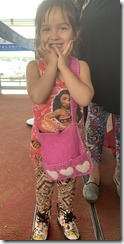




















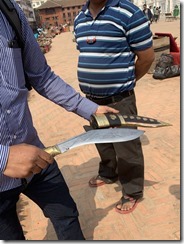



























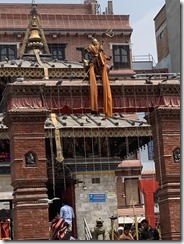






























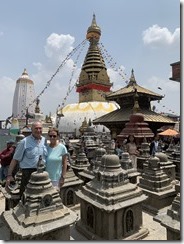
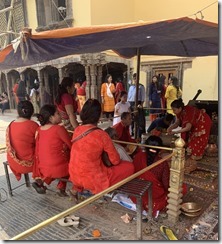











































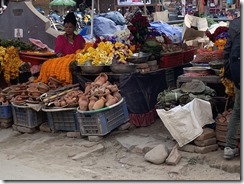








Looks like a great day… Thanks for the detailed account and super pictures!!
LikeLike
These are wonderful! I’m excited that you are sharing this excursion, as I’m planning a trip there in the fall.
Enjoy !!
LikeLike